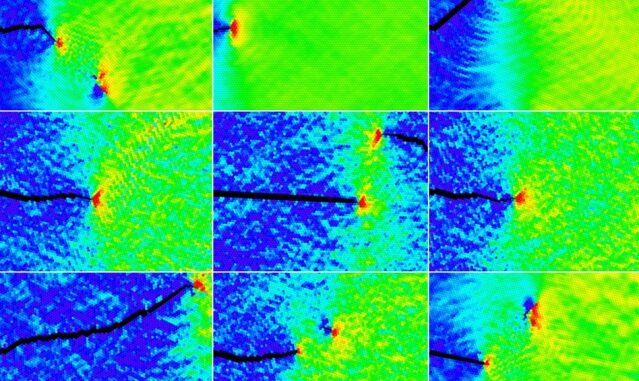
“Engineers develop a rapid screening system to test fracture resistance in billions of potential materials.”
Source: David L. Chandler | MIT News Office
For engineers developing new materials or protective coatings, there are billions of different possibilities to sort through. Lab tests or even detailed computer simulations to determine their exact properties, such as toughness, can take hours, days, or more for each variation. Now, a new artificial intelligence-based approach developed at MIT could reduce that to a matter of milliseconds, making it practical to screen vast arrays of candidate materials.
The system, which MIT researchers hope could be used to develop stronger protective coatings or structural materials — for example, to protect aircraft or spacecraft from impacts — is described in a paper in the journal Matter, by MIT postdoc Chi-Hua Yu, civil and environmental engineering professor and department head Markus J. Buehler, and Yu-Chuan Hsu at the National Taiwan University.
The focus of this work was on predicting the way a material would break or fracture, by analyzing the propagation of cracks through the material’s molecular structure. Buehler and his colleagues have spent many years studying fractures and other failure modes in great detail, since understanding failure processes is key to developing robust, reliable materials. “One of the specialties of my lab is to use what we call molecular dynamics simulations, or basically atom-by-atom simulations” of such processes, Buehler says.
These simulations provide a chemically accurate description of how fracturing happens, he says. But it’s slow, because it requires solving equations of motion for every single atom. “It takes a lot of time to simulate these processes,” he says. The team decided to explore ways of streamlining that process, using a machine-learning system.
“We’re kind of taking a detour,” he says. “We’ve been asking, what if you had just the observation of how fracturing happens [in a given material], and let computers learn this relationship itself?” To do that, artificial intelligence (AI) systems need a variety of examples to use as a training set, to learn about the correlations between the material’s characteristics and its performance.
In this case, they were looking at a variety of composite, layered coatings made of crystalline materials. The variables included the composition of the layers and the relative orientations of their orderly crystal structures, and the way those materials each responded to fracturing, based on the molecular dynamics simulations. “We basically simulate, atom by atom, how materials break, and we record that information,” Buehler says.

They painstakingly generated hundreds of such simulations, with a wide variety of structures, and subjected each one to many different simulated fractures. Then they fed large amounts of data about all these simulations into their AI system, to see if it could discover the underlying physical principles and predict the performance of a new material that was not part of the training set.
And it did. “That’s the really exciting thing,” Buehler says, “because the computer simulation through AI can do what normally takes a very long time using molecular dynamics, or using finite element simulations, which are another way that engineers solve this problem, and it’s very slow as well. So, this is a whole new way of simulating how materials fail.”
How materials fail is crucial information for any engineering project, Buehler emphasizes. Materials failures such as fractures are “one of the biggest reasons for losses in any industry. For inspecting planes or trains or cars, or for roads or infrastructure, or concrete, or steel corrosion, or to understand the fracture of biological tissues such as bone, the ability to simulate fracturing with AI, and doing that quickly and very efficiently, is a real game changer.”
The improvement in speed produced by using this method is remarkable. Hsu explains that “for single simulations in molecular dynamics, it has taken several hours to run the simulations, but in this artificial intelligence prediction, it only takes 10 milliseconds to go through all the predictions from the patterns, and show how a crack forms step by step.”
The method they developed is quite generalizable, Buehler says. “Even though in our paper we only applied it to one material with different crystal orientations, you can apply this methodology to much more complex materials.” And while they used data from atomistic simulations, the system could also be used to make predictions on the basis of experimental data such as images of a material undergoing fracturing.
“If we had a new material that we’ve never simulated before,” he says, “if we have a lot of images of the fracturing process, we can feed that data into the machine-learning model as well.” Whatever the input, simulated or experimental, the AI system essentially goes through the evolving process frame by frame, noting how each image differs from the one before in order to learn the underlying dynamics.
For example, as researchers make use of the new facilities in MIT.nano, the Institute’s facility dedicated to fabricating and testing materials at the nanoscale, vast amounts of new data about a variety of synthesized materials will be generated.
“As we have more and more high-throughput experimental techniques that can produce a lot of images very quickly, in an automated way, these kind of data sources can immediately be fed into the machine-learning model,” Buehler says. “We really think that the future will be one where we have a lot more integration between experiment and simulation, much more than we have in the past.”
The system could be applied not just to fracturing, as the team did in this initial demonstration, but to a wide variety of processes unfolding over time, he says, such as diffusion of one material into another, or corrosion processes. “Anytime where you have evolutions of physical fields, and we want to know how these fields evolve as a function of the microstructure,” he says, this method could be a boon.
The research was supported by the U.S. Office of Naval Research and the Army Research Office.







Leave a Reply